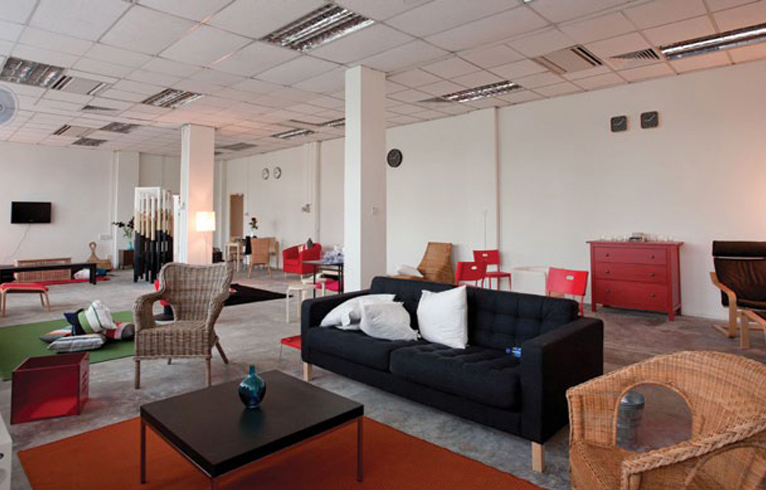SINGAPORE BIENNALE 2011
| August 3, 2011 | Post In LEAP 9

Biennales have largely become marketing events for nations and cities, used to show off an idealized image to outsiders. This edition of the Singapore Biennale, taking place in venues such as the National Museum of Singapore, Singapore Art Museum, Old Kallang Airport, and Marina Bay, continues to demonstrate the cultural strata of the country by coordinating venues of various functions.
The show revolves around the theme “Open House,” exploring locality and the processes of art production; artistic director Matthew Ngui and curators Trevor Smith and Russell Storer claim that one aim is to eradicate a public fear of art. This “friendly” Biennale, however, also exhibits, like any other exhibition, a number of works that showcase sheer scale, the aggression of which can only be softened, never fully mitigated. Take, for example, Michael Beutler’s Steamed Buns, an installation of gigantic pillars made from paper and metal wire. The structure bores down on an audience who walk through to other rooms in the building to route and trace the negative space of the work as a whole; intimidation and seduction generate fluctuations of distance between work and viewer.
Works that reflect on the relatively under-researched field of Singaporean art history are shown as well. Artists in the News is the work by Koh Nguang How, who has collected items related to Singaporean contemporary art from newspapers since the 1980s. Appearing as an enormous collection of art-related clippings, including the obituary notices of artists, personal fates are snuck into public space through lowly newspaper pages. John Low’s installations Ghost Stories and Skying more or less reconstruct the artist’s studio, creating a space for research into media reports on ghosts and the representation of the Singapore River in local art history.
Work involving intervention and social critique is easily accessible in the Biennale, the most outstanding of which may be Jill Magid’s video clips drawn from surveillance cameras in public areas in Manchester, attempting to decode the biopolitical gaze inscribed upon the body. Arin Rungjang’s Unequal Exchange/No Exchange Can be Equal, on the other hand, is an imitation of an Ikea showroom: mass-produced products from the world’s largest furniture retailer are deployed in high density, while the artist invites Thai migrants in Singapore to meet and rest among them. This use of workers and products to criticize the capitalism of empire, which can no longer be so simply summarized in the dialectic of insert distance between the imagery of the work and the object of its critique, causing a short circuit in potential interpretation. Simon Fujiwara’s installation Welcome to the Hotel Munber represents memories of events that never took place through an assortment of fabricated, personal, and historical discourses and other narratives, extending a smooth space into an ontological parallax gap.
Ultimately, the Biennale’s gesture of an open door does not produce closeness, but rather paradoxically permeates the exhibition with signs of distance, as encounters and confrontations between artists, viewers, works, spaces, cultural symbols, and concepts transform into aesthetic vectors that attract and collide. In some ways, the curatorial statement that seeks to erase the public’s fear of art may function as a case study in “paternalistic models of communication,” marking the great rift between different types of participants in the power structure of the art world. Fear is always an active and essential ingredient in art, working at a specific distance that consumes the outlines of the familiar symbolic and realistic worlds in an instant: fear becomes a reality that demands an immediate reaction, but will be substituted by another fear when it is situated too far from the viewing subject. The Singapore Biennale seems to mediate this distance and make it, in the words of Rilke, “the beginning of terror, which we are still just able to endure.” Venus Lau (Translated by Robin Peckham)

